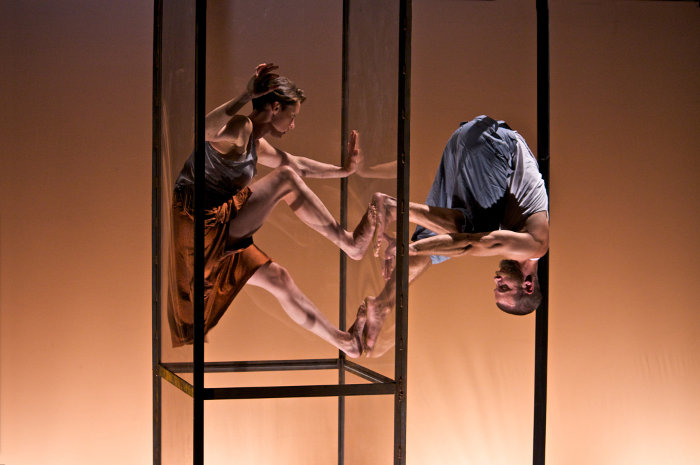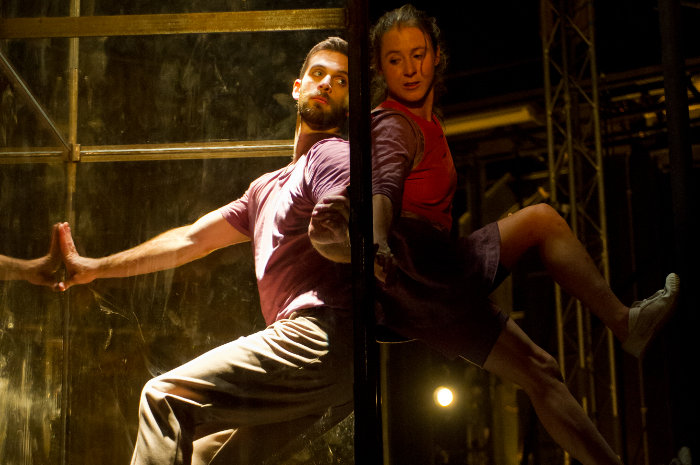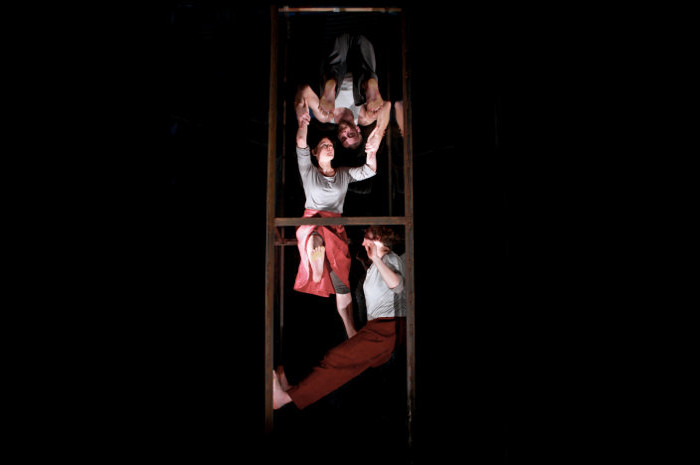In Ockham's Razor's Not Until We Are Lost the theatre is cleared of its seats and stage and the audience walk freely in the empty space surrounding three aerial structures. As in an art installation they can go (almost) where they please and watch from any angle, though the perspectives that matter most might be internal. Here two members of the company, Alex Harvey and Charlotte Mooney, reflect on the creation of the piece and the development of one particular scene...
The title of the show is a Henry David Thoreau quote: 'not until we are lost do we begin to find ourselves'. It struck a chord with us because it looks at lostness not just as a physical experience but as an emotional one, and it doesn't necessarily see being lost as a negative thing. Instead it gives this impression of lostness as being like a shift in perspective, like an opportunity, and that chimed with several of the ideas we had for the piece.
Right at the start of the NUWAL process, though, all we knew was that we wanted to make a show where the audience was on stage and where there'd be a choir embedded within that audience. Both ideas came from two previous shows we'd worked on, Something in the Air and Satyagraha. In Something in the Air, which we made with Oily Cart, we took an audience of six young people up in the air in specially built nest chairs and swung, bounced and spun them around. It was a very different interaction to have with an audience, to be so close to them, and from the audience's point of view it's rare to have that kind of direct kinaesthetic experience. We wanted to find a way of working more with that sort of performer-audience relationship. Satyagraha was something else again: a large-scale opera made by Improbable in collaboration with the English National Opera. The first rehearsal we went to was with all 40 members of the ENO chorus. We were in this tiny room with them and when they started to sing it was just so powerful to be close to that many singers. So we knew as well that if the audience was going to be on stage with us it was really important that they had a physical experience with the sound of the piece.
For all our productions we start by looking for a theme that will guide the work and provide a thread through the movement material – even if we change this theme later on. With NUWAL we started off looking at the idea of labyrinths and of the audience actually having an experience of becoming lost, or at least disorientated, in a space. Stepping onto the stage is quite an exciting – and frightening – thing to do, and we liked the idea that the audience would journey through a kind of story and a chain of experiences. We had the idea for a series of rooms that would transform around them, and built one during R&D that could grow and shrink, with the performance happening both inside and outside. When you stood in there and the room started to grow around you it felt like you were sinking, and it was a very physical feeling but also a very emotional feeling. A lot of people actually said it felt like being buried alive and didn't like it at all, but it was also kind of wonderful because you could look up and watch the white ceiling recede and disappear... The whole thing was very Alice in Wonderland. We still want to do it, but in the end it was too expensive.
When you start with the idea of giving the audience a feeling of disorientation, and with a theme of being lost and disorientated, then of course the dream scenario is to have bits of equipment and set that fly in and fly out and that come and disappear, or to have rooms that grow and transform around the audience. But the simpler – and more affordable – version of that, the one that we eventually arrived at, is you have an empty space with three pieces of equipment in it and the audience move between them, and the space is reconfigured by the movement of the audience.
Our company's working method has always been that we have a theme, create a piece of equipment or a structure which we think would produce movement reflecting that theme, and then we don't think about the theme – we put it to one side and just look at movement. For NUWAL we built three different structures: a perspex tower; a long wall of scaffolding that in one scene is fixed at a diagonal angle and in another is released to swing back and forth; and a fixed, vertical wall of scaffolding, the one in the extract, which we called the Stave.
The tower was one of the first things we had. It's aerial, but it's the opposite of aerial because there's no hanging – it's all pushing. At first, when we were still working on the labyrinth idea, we made it with wood thinking the audience would look down into it and get this unusual perspective – but dropped that because we'd only be able to have two or three people looking in at a time. That was one reason for making it in perspex, but we also really liked the idea that you could have something that the audience could surround entirely – that there would be one person inside who was isolated yet completely surrounded by people.




The development of the other pieces of equipment was totally cerebral. We looked at the tower and saw that it was about walls, and about the person inside being walled in – so we made walls of scaffolding. The Stave and the diagonal wall are two versions of the same thing – we were just playing with different profiles of the bars. Originally the Stave was a bit like a ladder, and then it got shortened and widened as it became more apparent what was interesting on it – which was being able to sort of curl along the length of it, sliding along the bars. Because it's fixed it's also the most solid piece of equipment we've ever created. It's actually sort of the most perfect thing to move on. The first bar is at your toe, then it hits the back of your hocks, then the next bar hits your hips, and then it hits your armpit.
There was a stage in the rehearsal process where the Stave was a real sticking point – we couldn't pin down the story of what was happening. To start with we had all five of us on there and were doing loads of synchronised choreography, and it started to seem like it might be an ugly duckling piece with one person getting the choreography wrong and a whole narrative running through that. But we kept not getting round to doing it and it just didn't seem to settle, and then, because we were working on unrubberised bars, Tina and Amelia got RSI in their forearms.
So they were resting their forearms and it was kind of getting on in the development process. We'd done everything else we could do and had progressed to rehearsing the other scenes, and one day it was the three of us in the rehearsal space saying, We just need to get on and make this – let's just do it with the three of us. So all of the movement was born out of what happens with three people on that structure.
The three of us have a very silly, playful relationship, and that was where the tone of the piece came from. We ended up making the scene in two or three days because it was so easy. It just naturally fell into this obvious and simple story – that a person gets lost and the solution is that other people draw them out – which fitted the overall arc of the piece.
Working with circus we've found the thing that works best for us is if the circus actions themselves – lifting another person, climbing something, and so on – are metaphorical rather than literal. We want each scene or little play to be open to many different readings because that's what makes the work universal, and even though we work for a narrative arc we like that different people will have different interpretations of that arc.
But one thing we did wonder, with this particular scene, is can you get away from sex? We really, really didn't want to make a scene that people would see as being two guys picking up a girl, and to us it wasn't that at all. It was actually very difficult. Perhaps it's just because circus is extremely physical in a way that people are unused to, and muscles and strength are inherently quite sexy, but we found we had to be really careful with the body language in the scene. Luke and Alex constantly have to exchange looks to signal to the audience that they're not in competition. We worked with Matilda Leyser as an outside eye on the scene and we asked her how much of the looking we should choreograph. Our instinct was to set it, but she said not to fix anything. So the movement is mostly the same, but the rhythm of the decision of when to look is different every night to keep it alive.
The other big thing in this scene is that it's the first moment when the audience becomes aware of the choir. When we first started playing around with choirs we had a session where we stood and got the choir to just walk really slowly toward us singing. This was a community choir in Manchester, and there was something about looking at the singers and seeing how they're just normal people – people who've come to do their evening choir practice – but seeing as well how they're transformed by the singing. We found it really moving and we wanted to have that moment where they're like a reflection of you.
It was doing Satyagraha in New York that we decided we wanted Graham Fitkin to write the music for NUWAL. It came from listening to Philip Glass all day, every day, and feeling that it was something like that, something minimal, that we really wanted. The music in the extract is actually the first incarnation of the piece Graham wrote, before having seen the show. It was really the moment where he did 'lost' in the show – it's the most disjointed, inharmonious piece. The problem was that it didn't fit our arc – the end of it, the lostness, is how the scene is tonally at the beginning – and after seeing the full performance Graham rewrote the music to something that followed the movement, something that had more of a swing to it, as well as making it technically an easier piece for the choir to sing.
The choir is different each time, because a really important part of this project has been that at every venue we've gone to we've gotten twenty local singers to join us. It's been quite a wild thing – each time having a new group of twenty terrified singers, who, at the start of that process, always, are really lost. Their role in the show, apart from to sing, is to martial the audience – they give a lot of cues to them about where to go – and they also fill the atmosphere in the room. At each venue we do a lot of ensemble and performance work with them, and going on that journey with twenty people who've never done a performance before is always really emotional.
It's interesting that in the extract for the first 30 seconds it's quite dark and there's a lot of really lost-looking audience members wandering around. Out of that you don't really know where the action's going to come from next; the choir singing amongst the audience disorientates them even more and then it resolves itself eventually into a rope leading them away to where they'll be standing, and them looking up at the Stave. And then the choir are suddenly assembled behind it. And that's sort of a human way of flying in a bit of scenery and flying out a bit of scenery and making it a room that transforms – out of the chaos of a room it settles itself into a new configuration. It was the simplest way to do it.
Ockham's Razor was founded in 2004 by its three core members – Alex Harvey, Charlotte Mooney and Tina Koch. The company is produced by Turtle Key Arts.
Charlotte Mooney and Alex Harvey were interviewed by John Ellingsworth 16 September 2013 in the Royal Festival Hall, on the east side of the ground floor by the sunken ballroom. For more on Ockham's Razor's work see the company's website.
This interview was produced as part of the project Deconstructing Circus with the support of Arts Council England.